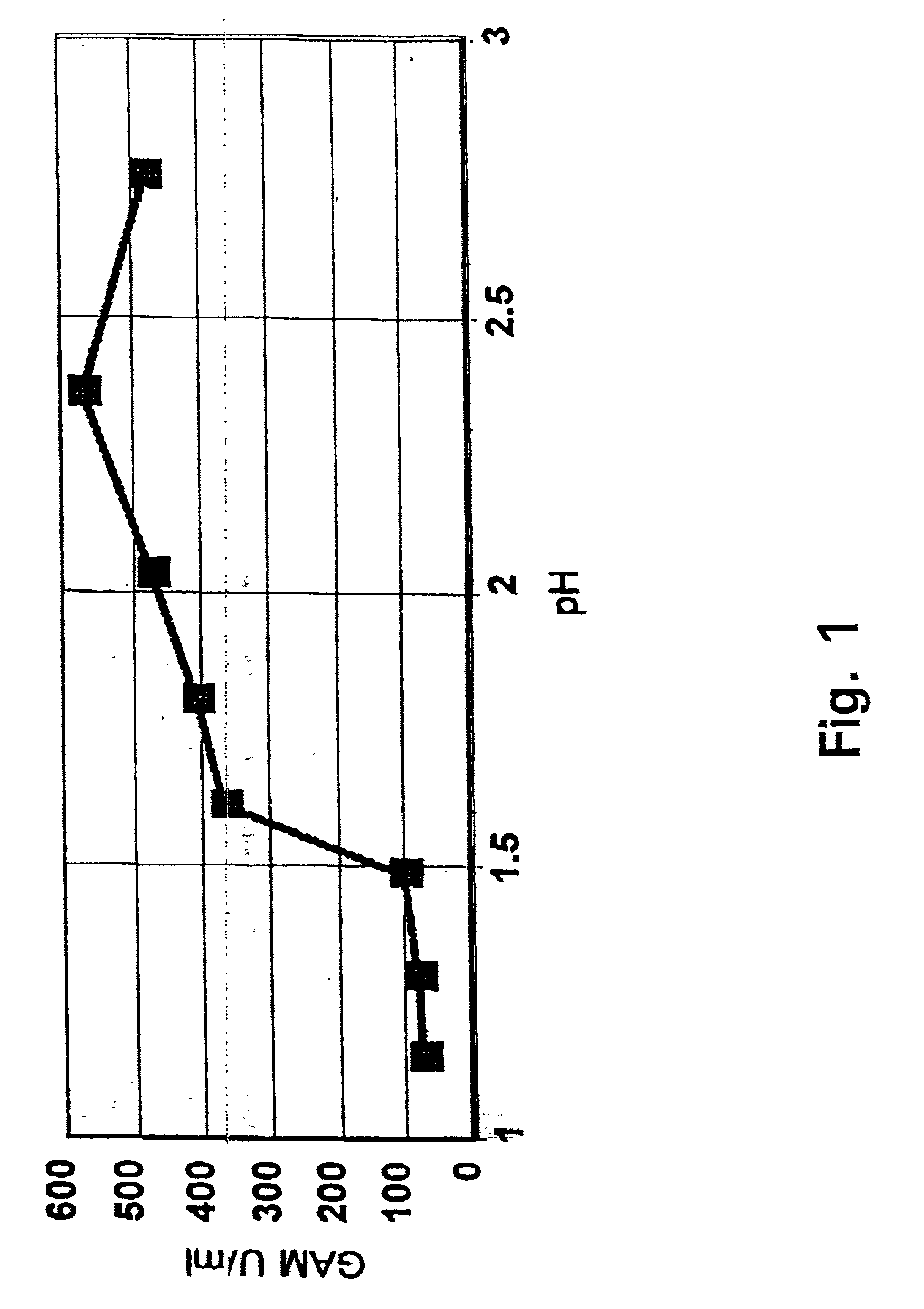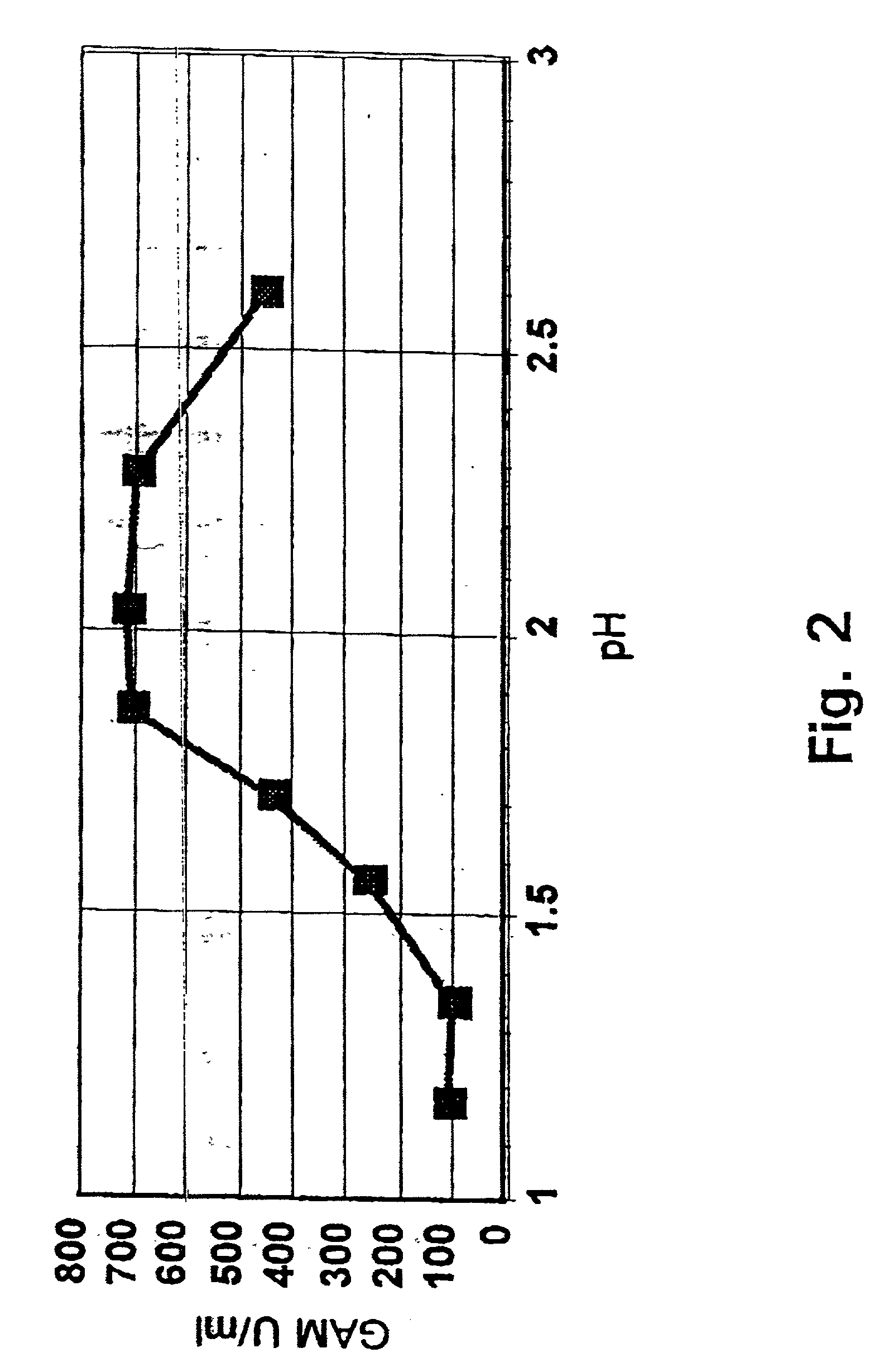Method of providing polypeptide preparations with reduced enzymatic side activities
a technology of enzymatic side activity and polypeptide, which is applied in the field of polypeptide products, can solve the problems of significant pollution problem, increased production cost, and labour intensive process
- Summary
- Abstract
- Description
- Claims
- Application Information
AI Technical Summary
Benefits of technology
Problems solved by technology
Method used
Image
Examples
example 1
[0039] Inactivation of Glucoamylase in a Recombinant Chymosin Preparation
[0040] In this study, a filtrate derived from the cultivation of a recombinant strain of Aspergillus niger var. awamori expressing a prochymosin-glucomylase fusion protein was used as test material. The filtrate was obtained from an industrial fermentation process by acidifying the cultivation medium after completion of the fermentation to inactivate the fungal biomass followed by separating the biomass by filtration.
[0041] The crude filtrate had a pH of about 2.2, contained 31.13 U / ml of glucoamylase activity and had a conductivity of 19 mS (1 GAM unit is defined as the amount of activity that hydrolyses starch by generating 1 .mu.g glucose per min under the below standard conditions). The milk clotting activity of the filtrate was 98.5 International Milk Clotting Units (IMCUs) per ml. Prior to testing, the filtrate was diluted 5 times with distilled water. As a control, a commercial preparation of pure glucoa...
example 2
[0044] Inactivation of Enzymatic Side Activities in a Filtrate of Fermentation Medium of a Recombinant Chymosin-Producing Aspergillus niger var. awamori Strain
[0045] The starting material for this experiment was a fresh fermentate of Aspergillus niger var. awamori transformed with a plasmid expressing a prochymosin-glucoamylase fusion protein. The fermentate contained a milk clotting activity of 157.5 IMCU / ml, pH 5.59.
[0046] Samples to be tested in the experiment were prepared as follows: To 600 ml of the crude fermentate 5.4 ml of 100% acetic acid (0.9%) was added and pH was adjusted to 2.5 by addition of concentrated sulphuric acid (5 ml). A 50 ml sample was withdrawn and pH further adjusted to 1.8, 1.7 and 1.6, respectively, and a 50 ml sample collected at each pH. As control 50 ml of fermentate before pH adjustment was used.
[0047] Each of the above samples were centrifuged at 3.000 rpm for 10 minutes and subsequently filtered using a prefilter followed by filtration through a 0....
example 3
[0063] Inactivation of Enzymatic Side Activities in Final Ready-to-Use Rennet Products by Low pH Treatment
[0064] In this experiment, samples of the following commercial microbial and animal rennet products were subjected to pH 1.7 for 2.5 hours and the GAM activity and the overall starch degrading activity was measured before and after that treatment.
[0065] The tested products were: Hannilase.TM.195, a microbial coagulant produced by Rhizomucor miehei, Hannilase.TM.2100, also a microbial rennet produced by Rhizomucor miehei, CHY-MAX.TM., a bovine chymosin produced by Aspergillus niger var. awamori, Modilase.TM. 195, a oxidised, thermobile coagulant derived from Rhizomucor miehei and Thermolase.TM., a microbial coagulant produced by Cryphonectria parasitica.
[0066] The above products were tested for GAM activity using the assay described in Example 1 and for total starch degrading activity using an agar diffusion test. The results of this assay was indicated as +++, ++, + or (+), wher...
PUM
| Property | Measurement | Unit |
|---|---|---|
| Fraction | aaaaa | aaaaa |
| Fraction | aaaaa | aaaaa |
| Fraction | aaaaa | aaaaa |
Abstract
Description
Claims
Application Information
 Login to View More
Login to View More - R&D
- Intellectual Property
- Life Sciences
- Materials
- Tech Scout
- Unparalleled Data Quality
- Higher Quality Content
- 60% Fewer Hallucinations
Browse by: Latest US Patents, China's latest patents, Technical Efficacy Thesaurus, Application Domain, Technology Topic, Popular Technical Reports.
© 2025 PatSnap. All rights reserved.Legal|Privacy policy|Modern Slavery Act Transparency Statement|Sitemap|About US| Contact US: help@patsnap.com


